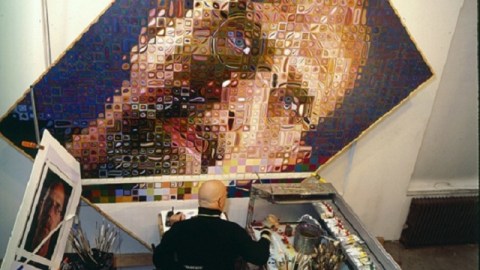Close Examination: A Chuck Close Portrait on Film

“Chucky Fat Face,” artist Chuck Close admits to being called by fellow artist Richard Serra during their graduate school days together at Yale early on in the film Chuck Close, Marion Cajori’s lauded documentary now available on DVD for the first time from New Video. In Cajori’s film, we see Close full face—both while painting one of his signature self-portraits and through the eyes of his fellow artists and his family. It is this combination of intimate close examination and wide-angle perspective that makes Chuck Close not only an unforgettable study of an individual artist, but also a thought-provoking examination of twentieth-century art and how modern artists mentally approach their art.
Cajori passed away in 2006 after finishing production of the film, which was released theatrically in 2007. In 1998, she won an Emmy for “Chuck Close: A Portrait in Progress,” which aired on PBS. The success of that short film spurred her to expand on Close as a subject and bring in more of the material she gathered in interviews with Close’s closest friends, who just happen to be some of the most intriguing American artists of the last half century.
We see the process of Close creating his supersized, super-close-up portraits from the initial photography to finished product—a portrait composed of a grid of tiny abstract paintings that gel at a distance into a non-portrait portrait that denies the illusion of photography while creating a new kind of living illusion. Cajori intersperses shots of Close at work with brief interviews with other artists who discuss Close’s work in the context of their own vision. Many of the insights linger with you well after the film ends. Brice Marden expounds on the tension of abstraction versus figuration in Close’s work, arriving at the final judgment that Close uses “the image as a convenience” to move beyond illusion into the realm of pure energy. Dorothea Rockburne, a total abstractionist, praises Close as one of the “few people who have gotten past Matisse.” Those are just a couple of the many gems that fall from the lips of artists such as Janet Fish, Robert Rauschenberg, Alex Katz, Elizabeth Murray, Lucas Samaras, and Kiki Smith. Serra seems conspicuous by his absence, but classical composer Philip Glass, who assisted Serra and met Close through Serra, more than makes up for Serra by giving a cross-disciplinary perspective on Close’s art as an art of “process,” much like Glass’ own music.
This is a heady film in many ways. Close and his circle think through their art deeply. Fortunately, they are as gifted with words as they are with images and sculpture. And, yet, the human element never gets swamped by the intellectual. Watching Close paint while whistling and humming along to Nina Simone in the background, you share in his pure joy in the work. At one point Cajori mounted a camera onto Close’s brush, providing a dizzying trip inside the creative process itself. When the film explores the 1988 spinal artery collapse that left Close paralyzed in a wheelchair through the words of his wife, Leslie, and his daughters, Maggie and Georgia, you initially experience the anguish of that cataclysm, but the triumph of how they rebounded and flourished through Close’s art quickly brings you back to a better place.
At one point, Brice Marden quotes the classical music author Maynard Solomon talking about Beethoven’s music (and, by extension, all great art) as a “self-renewable energy source.” Chuck Close is a self-renewing source of creative energy in that it inspires you to see the world in a different way while simultaneously renewing your faith in the human spirit through Close’s refusal to stop working as an artist when his legs stopped working. Now that it is available on DVD, Chuck Close can be close at hand, ready to view whenever you need a recharge.
[Many thanks to New Video for providing me with a review copy of Chuck Close.]





